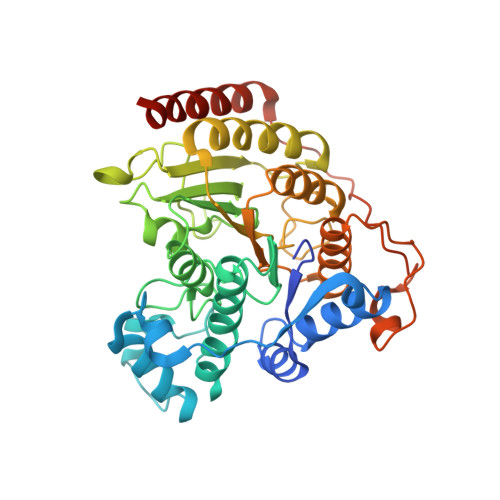Structural studies of human histone deacetylase 8 and its site-specific variants complexed with substrate and inhibitors.
Dowling, D.P., Gantt, S.L., Gattis, S.G., Fierke, C.A., Christianson, D.W.(2008) Biochemistry 47: 13554-13563
- PubMed: 19053282
- DOI: https://doi.org/10.1021/bi801610c
- Primary Citation of Related Structures:
3EW8, 3EWF, 3EZP, 3EZT, 3F06, 3F07, 3F0R - PubMed Abstract:
Metal-dependent histone deacetylases (HDACs) require Zn(2+) or Fe(2+) to regulate the acetylation of lysine residues in histones and other proteins in eukaryotic cells. Isozyme HDAC8 is perhaps the archetypical member of the class I HDAC family and serves as a paradigm for studying structure-function relationships. Here, we report the structures of HDAC8 complexes with trichostatin A and 3-(1-methyl-4-phenylacetyl-1H-2-pyrrolyl)-N-hydroxy-2-propenamide (APHA) in a new crystal form. The structure of the APHA complex reveals that the hydroxamate CO group accepts a hydrogen bond from Y306 but does not coordinate to Zn(2+) with favorable geometry, perhaps due to the constraints of its extended pi system. Additionally, since APHA binds to only two of the three protein molecules in the asymmetric unit of this complex, the structure of the third monomer represents the first structure of HDAC8 in the unliganded state. Comparison of unliganded and liganded structures illustrates ligand-induced conformational changes in the L2 loop that likely accompany substrate binding and catalysis. Furthermore, these structures, along with those of the D101N, D101E, D101A, and D101L variants, support the proposal that D101 is critical for the function of the L2 loop. However, amino acid substitutions for D101 can also trigger conformational changes of Y111 and W141 that perturb the substrate binding site. Finally, the structure of H143A HDAC8 complexed with an intact acetylated tetrapeptide substrate molecule confirms the importance of D101 for substrate binding and reveals how Y306 and the active site zinc ion together bind and activate the scissile amide linkage of acetyllysine.
- Roy and Diana Vagelos Laboratories, Department of Chemistry, University of Pennsylvania, Philadelphia, Pennsylvania 19104-6323, USA.
Organizational Affiliation:



















